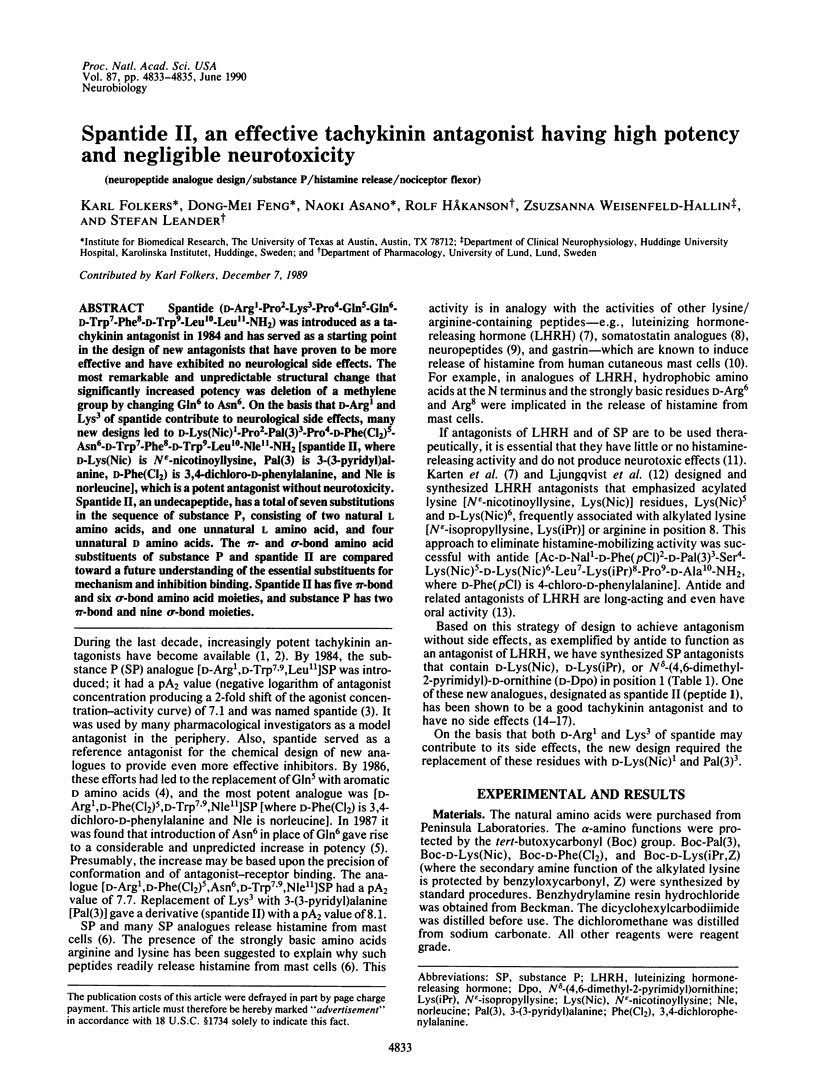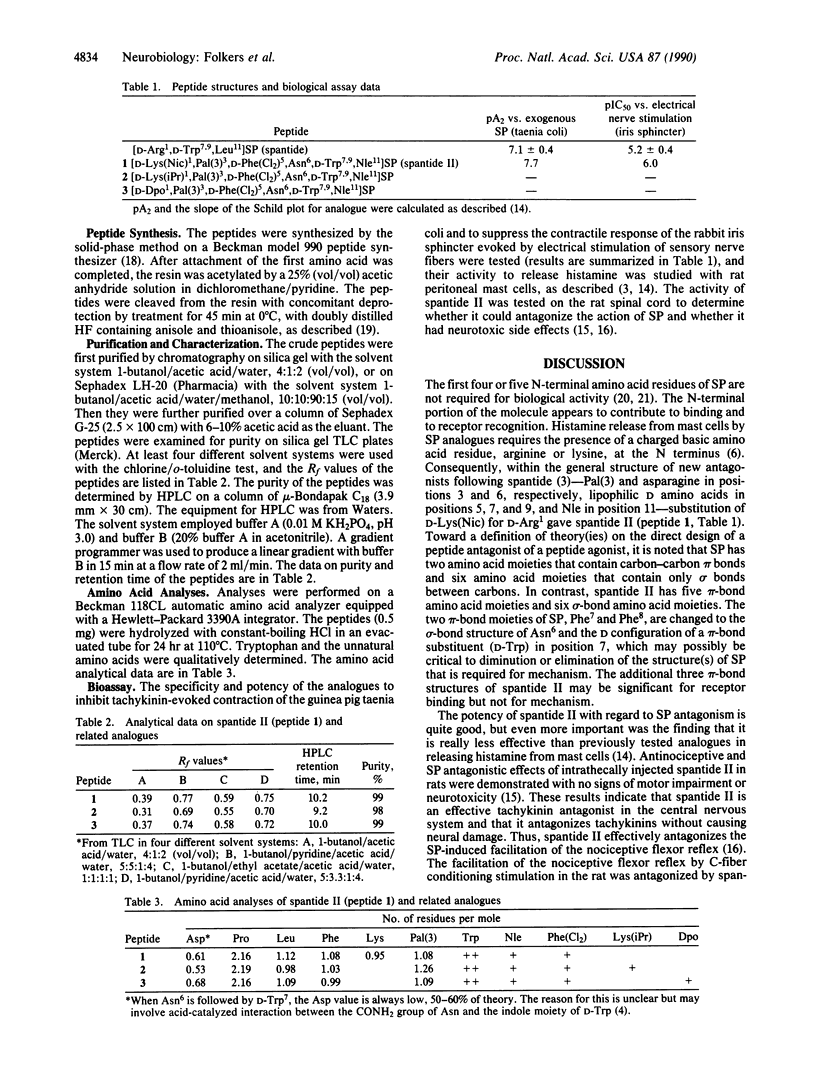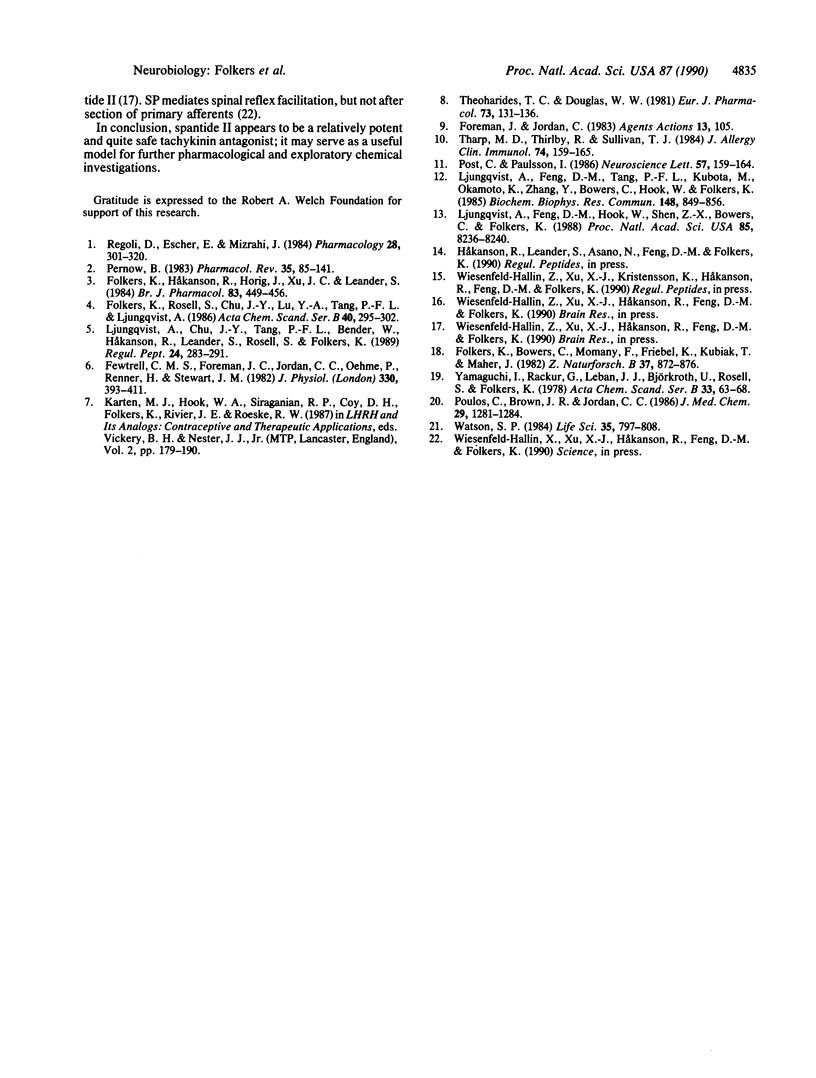Abstract
Spantide (D-Arg1-Pro2-Lys3-Pro4-Gln5-Gln6-D-Trp7-Phe8-D-Trp9-++ +Leu10-Leu11-NH2) was introduced as a tachykinin antagonist in 1984 and has served as a starting point in the design of new antagonists that have proven to be more effective and have exhibited no neurological side effects. The most remarkable and unpredictable structural change that significantly increased potency was deletion of a methylene group by changing Gln6 to Asn6. On the basis that D-Arg1 and Lys3 of spantide contribute to neurological side effects, many new designs led to D-Lys(Nic)1-Pro2-Pal(3)3-Pro4-D-Phe(Cl2)5-Asn6-D-Trp7-Phe8-D-Trp9- Leu10-Nle11- NH2 [spantide II, where D-Lys(Nic) is N epsilon-nicotinoyllysine, Pal(3) is 3-(3-pyridyl)alanine, D-Phe(Cl2) is 3,4-dichloro-D-phenylalanine, and Nle is norleucine], which is a potent antagonist without neurotoxicity. Spantide II, an undecapeptide, has a total of seven substitutions in the sequence of substance P, consisting of two natural L amino acids, and one unnatural L amino acid, and four unnatural D amino acids. The pi- and sigma-bond amino acid substituents of substance P and spantide II are compared toward a future understanding of the essential substituents for mechanism and inhibition binding. Spantide II has five pi-bond and six sigma-bond amino acid moieties, and substance P has two pi-bond and nine sigma-bond moieties.
Full text
PDF


Selected References
These references are in PubMed. This may not be the complete list of references from this article.
- Fewtrell C. M., Foreman J. C., Jordan C. C., Oehme P., Renner H., Stewart J. M. The effects of substance P on histamine and 5-hydroxytryptamine release in the rat. J Physiol. 1982 Sep;330:393–411. doi: 10.1113/jphysiol.1982.sp014347. [DOI] [PMC free article] [PubMed] [Google Scholar]
- Folkers K., Håkanson R., Hörig J., Xu J. C., Leander S. Biological evaluation of substance P antagonists. Br J Pharmacol. 1984 Oct;83(2):449–456. doi: 10.1111/j.1476-5381.1984.tb16506.x. [DOI] [PMC free article] [PubMed] [Google Scholar]
- Folkers K., Rosell S., Chu J. Y., Lu L. A., Tang P. F., Ljungqvist A. Design and synthesis of antagonists of substance P. Acta Chem Scand B. 1986 Apr;40(4):295–302. doi: 10.3891/acta.chem.scand.40b-0295. [DOI] [PubMed] [Google Scholar]
- Foreman J., Jordan C. Histamine release and vascular changes induced by neuropeptides. Agents Actions. 1983 Apr;13(2-3):105–116. doi: 10.1007/BF01967311. [DOI] [PubMed] [Google Scholar]
- Ljungqvist A., Chu J. Y., Tang P. F., Bender W., Håkanson R., Leander S., Rosell S., Folkers K. Increased potency of antagonists of substance P having asparagine in position 6. Regul Pept. 1989 Mar;24(3):283–291. doi: 10.1016/0167-0115(89)90224-3. [DOI] [PubMed] [Google Scholar]
- Ljungqvist A., Feng D. M., Hook W., Shen Z. X., Bowers C., Folkers K. Antide and related antagonists of luteinizing hormone release with long action and oral activity. Proc Natl Acad Sci U S A. 1988 Nov;85(21):8236–8240. doi: 10.1073/pnas.85.21.8236. [DOI] [PMC free article] [PubMed] [Google Scholar]
- Ljungqvist A., Feng D. M., Tang P. F., Kubota M., Okamoto T., Zhang Y. W., Bowers C. Y., Hook W. A., Folkers K. Design, synthesis and bioassays of antagonists of LHRH which have high antiovulatory activity and release negligible histamine. Biochem Biophys Res Commun. 1987 Oct 29;148(2):849–856. doi: 10.1016/0006-291x(87)90953-3. [DOI] [PubMed] [Google Scholar]
- Pernow B. Substance P. Pharmacol Rev. 1983 Jun;35(2):85–141. [PubMed] [Google Scholar]
- Post C., Paulsson I. Antinociceptive and neurotoxic actions of substance P analogues in the rat's spinal cord after intrathecal administration. Neurosci Lett. 1985 Jun 12;57(2):159–164. doi: 10.1016/0304-3940(85)90056-4. [DOI] [PubMed] [Google Scholar]
- Poulos C., Brown J. R., Jordan C. C. Synthesis and biological activity of substance P C-terminal hexapeptide analogues: structure-activity studies. J Med Chem. 1986 Jul;29(7):1281–1284. doi: 10.1021/jm00157a028. [DOI] [PubMed] [Google Scholar]
- Regoli D., Escher E., Mizrahi J. Substance P--structure-activity studies and the development of antagonists. Pharmacology. 1984;28(6):301–320. doi: 10.1159/000137979. [DOI] [PubMed] [Google Scholar]
- Tharp M. D., Thirlby R., Sullivan T. J. Gastrin induces histamine release from human cutaneous mast cells. J Allergy Clin Immunol. 1984 Aug;74(2):159–165. doi: 10.1016/0091-6749(84)90280-x. [DOI] [PubMed] [Google Scholar]
- Theoharides T. C., Douglas W. W. Mast cell histamine secretion in response to somatostatin analogues: structural considerations. Eur J Pharmacol. 1981 Jul 17;73(2-3):131–136. doi: 10.1016/0014-2999(81)90084-4. [DOI] [PubMed] [Google Scholar]
- Watson S. P. Are the proposed substance P receptor sub-types, substance P receptors? Life Sci. 1984 Aug 20;35(8):797–808. doi: 10.1016/0024-3205(84)90403-x. [DOI] [PubMed] [Google Scholar]


